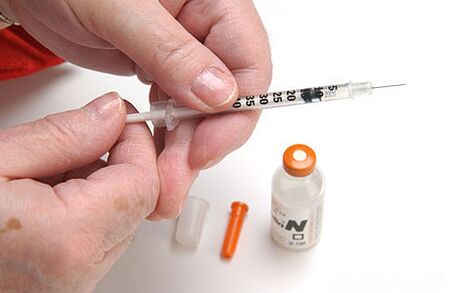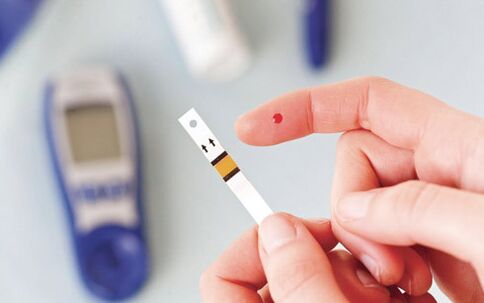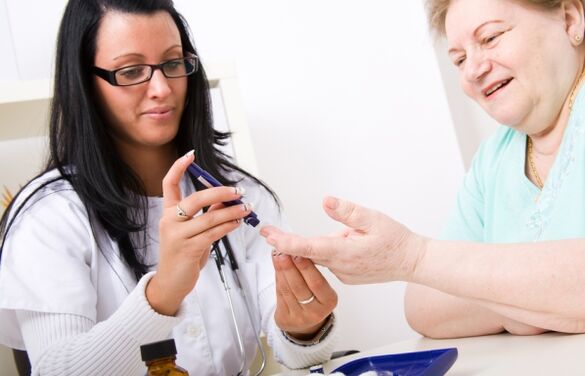Insulin - the hormonal secret of the processor, plays an important role, ensuring the stability of blood glucose. Diabetes mellitus is a consequence of the lack of this hormone. Complications caused by the disease often lead to death. The basic principles of diabetes treatment are strict adherence to diet, taking medication or insulin injections, tracking blood glucose levels, observing your body so as not to lose the first signs of complications.

The pathogenesis of the disease
Diabetes mellitus is a constant violation of the synthesis of the insulin hormone and its interaction with tissues in the body.
Insulin processes the sugar taken into the glucose and passes it through cell membranes. Thus, the hormone lowers the blood sugar rate and supplies the cells with food. Lack of insulin with damaged tissue sensitivity leads to the fact that glucose does not participate in metabolism and continues to circulate through the body. Biology of not only carbohydrate metabolism is lost, but also fat, protein, water salt.
Increased sugar increases the amount of lipid fractions in the bloodstream, which contributes to the development of atherosclerosis. The transformation of glucose into the glycogen slows down, and the body begins to use fat as sources. Fatty acids break down and ketone bodies appear to cause damage to the central nervous system.
Causes and currents
Insulin production is concerned due to damage to beta cell synthesis. The main risk factor for diabetes is inheritance, which significantly increases the effect of other factors. The probability of getting sick increases with age. Causes of diabetes:
The disease exists in the role of independent pathology and as a temporary symptom. The causes of diabetes mellitus can be the consequences of the work errors of the endocrine organs (hyperthyroidism, fechromocytoma). Symptomatic surplus of glucose discovered during pregnancy (including the use of IVF) is called gestational diabetes. Hyperglycemia occurs as a side effect of prolonged use of certain medicines (glucocorticoids, estrogen, psychotropic drugs) when exposed to toxic substances.
Hyperglycemia signals diabetes only in the presence of insulin errors, the appearance of symptoms of sugar disease.
Types of Diabetic Pathology

Diabetes mellitus is a violation of carbohydrates and water metabolism in the body.
WHO classification defines two main types of disease: insulin dependent (type I) and reverse form -Insulin dependent diabetes (type II). They differ in the reasons for the appearance and details of the pathogenesis, the nature of the course, have their treatment characteristics, but the consequences are just as dangerous.
rigor
The severity of the development of diabetes mellitus in the stage of glycemia, glucosuria, the degree of dysfunction of the target organs, determines the presence of complications, which indicates the abilities of body compensation. There are 4 degrees of severity. If the diabetes passes to a soft scale, then the treatment and food are chosen correctly. The degree of diabetes and symptoms are described in the table.
Characteristic symptoms of diabetes

The clinical signs of the disease are in most cases characterized by a gradual course.
Diabetes in adults may not immediately declare that it leads to the development of complications. Type I diabetes is developing rapidly with high glycemia and coma. The intensity of the symptoms of acquired diabetes is associated with the degree of lack of insulin products, the individual's body's individuality. You need to pass a test to determine the degree of blood sugar, if one of the symptoms appears:
The consequences of glycemia
Diabetes mellitus is a secret disease. Excessive blood sugar damages blood vessels, causes wall damage. Excess glucose is transformed into fat deposits. This leads to overweight and steatogepatosis (accumulation of lipids in hepatic cells). Glucose causes glycolization of membrane protein. The oxidizing process is able to cause damaged protein function and toxic appearance by -products. Damaged proteins cause disturbances in the structure of the organs. The accumulation of toxins and ketones causes damage to the patient's nervous system, up to disorders in the mind and coma. Excessive blood cholesterol is placed on the arterial walls in the damaged areas and forms atherosclerosis plaques, contributing to the angiopathies of the eyes, vessels and other organs.
The excess rate of blood glucose level determines the complexity of the course of the disease.
The risk of complications

Complicated diabetes mellitus carries the risk of the life of a sick person, so it is so important to identify the disease in time and begin treatment. The disease has worsened for 10-15 years. The complications that appear progress quickly and it is not easy to cope with them. Acute complications with primary diabetes (hypo- and hyperglycemia) are caused by sharp fluctuations in blood sugar. A list of states that complicate the disease of diabetics:
Troubleshooting
Diagnosis of diabetes determines the type of disease, severity, presence of internal organs lesions. Studies can be done repeatedly to assess the degree of progression of the disease and the effect of treatment. The diagnostic criteria for diabetes are characteristic signs of diabetes and the degree of glucose elevation. To confirm the diagnosis, urine and blood tests are done instrumental studies:
In healthy people, blood glucose levels are in range 3. 3-5. 5 mmol/l.
Treatment of the disease

In the presence of suspicion of diabetes mellitus, this diagnosis must be confirmed or rejected.
Diabetes mellitus is a chronic pathology that needs to be treated for life.
Principles of Diabetes Treatment - Sugar control in blood flow glucometer and prevent complications by observing diet and taking medication.
An endocrinologist can treat the disease, a cardiologist, a neuropathologist, an ophthalmologist, a vascular surgeon are related.
Modern methods of treatment - medication, diet, physical education - slow the progression of the disease.
medicaments
The doctor chooses the medicine, given the type of disease. Type 1 diabetes mellitus requires only insulin therapy, type 2 diabetes can be treated with sugar. The tablets operate in the pancreas, increase the sensitivity of the peripheral tissue. Such medicines are used:
Diabetes
Diabetes treatment certainly involves a diet by choosing calorie content, excluding easily soluble carbohydrates, sweets. Diabetes requires partial power. At the same time, the ratio of nutrients remains close to physiology. Sugar is replaced with xylitol or sorbitol. In the middle and severe forms of the disease, diet no. 9. It is allowed to eat soups with vegetables, low types of fish and meat, sour dairy products and cheese, cereals (buckwheat, barley oatmeal), fruits, sweet and sour taste berries. You can never eat sdoba, sweets, greasy dishes, rice belly, pasta, grapes, salty vegetables, marinated.
PREVENTION
The appearance of type 1 disease can not always be affected, as it can provoke a viral pathogen. The reason for developing type 2 diabetes is considered an unhealthy lifestyle, especially in people with hereditary prerequisites. Prevention measures if diagnosed sugar is diagnosed: proper nutrition in small portions with a minimum of easily soluble carbohydrates and fat, maintaining optimal body weight. Hypertension is also performed by controlling blood pressure numbers. Periodically, you should donate blood to the content of glucose and lipid blood fractions. Moderate physical activity will help keep the body in tone.























